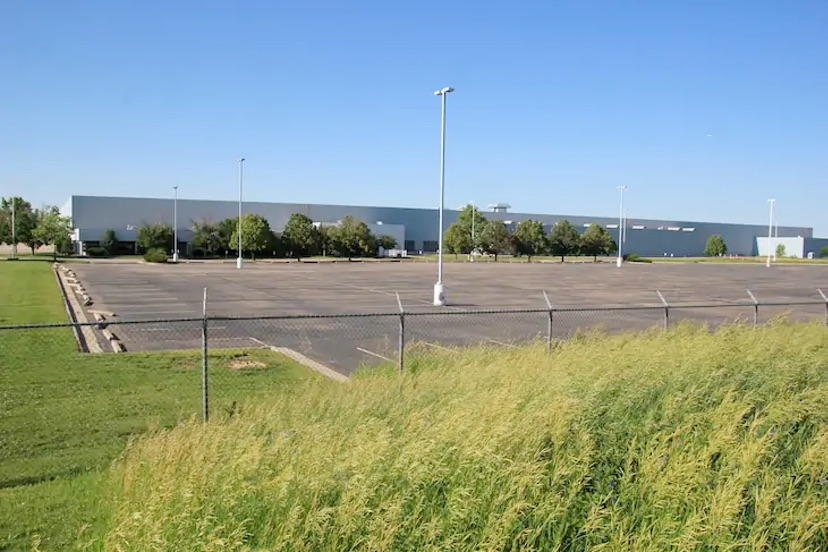PHOTO: Amprius Technologies plans to move into this warehouse in Brighton that was formerly used as a distribution center for Sears and Kmart. Photo by Allen Best.
Every transition produces winners and losers. U.S. fiscal policy shifted in the 1880s and the economy of Aspen cratered for decades. Some silver-mining towns never recovered.
In the 1980s, newspapers were plentiful. Ink now stains far fewer printers and editorial wretches.
Amazon thrives but Sears and Kmart, no more.
How will Colorado’s coal-based towns transition as we quell emissions from energy production? Legislation of recent years seeks to deliver what lawmakers call a just transition, meaning that Pueblo, Craig and other coal-based communities will stay on their feet.
The newest round of job-producing investments in emission-free technologies, though, call into question how difficult that will be. Two new factories are to be created in Brighton, on metropolitan Denver’s northeastern fringe. The combined investment of $450 million will deliver more than 1,200 average- to better-paying jobs.
VSK Energy will manufacture solar photovoltaic panels and will employ more than 900 people. It is a direct result of incentives in the federal Inflation Reduction Act of 2022, which seeks to restore U.S. manufacturing of renewable energy components.
The second factory will produce a new generation of energy-rich lithium-ion batteries. The company, Amprius Technology, says that a new anode, which will use silicon mined in Montana, will double the range of a Tesla, allowing it more than enough capacity to roam Colorado from corner to corner and the ability to juice up to 80% capacity in six minutes. The company also says the new batteries will deliver value to drones and aircraft. Sounds like a game-changer.
Both companies cited proximity to Interstate 76 as a significant consideration in siting their factories. They also have proximity to I-25, I-70 and I-80 plus Denver International Airport. If of not immediate importance, they also have access to transcontinental rail lines.
Availability of a large, skilled workforce was also cited. The battery company also cited the proximity of the Colorado School of Mines and other universities. It will employ a half-dozen Ph.Ds. in the research facility associated with the factory.
Something more intangible was also in play. It was described as a “strong cultural fit” by Ashwini Agarwal, the leader of Vikram Solar, the parent company for the solar manufacturer. Supply chains matter, but Colorado’s initiative in accelerating the energy transition also matters.
Andrew Huie, the vice president of infrastructure for Amprius, said something similar. “Colorado and Gov. Polis are embracing clean energy, and batteries align with Colorado’s clean energy goals,” he told me. “There may be synergies.”
Other companies are also carving out futures in this new energy economy along the Front Range. The Denver Business Journal recently cited three companies from Denver to Fort Collins that hope to stake a future with new batteries. And Lightning eMotors manufactures electric vehicles in Loveland.
Brighton already has Vestas, which arrived in 2010 to manufacture nacelles, containing the gearboxes and drive trains for wind turbines. Vestas also built a factory in Pueblo, near the Comanche Generating Station.
CS Wind, now the owner of the Pueblo factory, this year began an expansion that will add 850 jobs. It cited Inflation Reduction Act provisions that encourage wind production.
Jeffrey Shaw, president of the Pueblo Economic Development Corporation, said he expects announcement of other renewable-sector projects in the Pueblo area and probably throughout the state during the next 12 to 18 months. “A lot of it has to do with the Inflation Reduction Act,” he said, and in particular the law’s buy-American provision.
Already, Pueblo County has been rapidly adding both solar and storage. But so far, the new tax base for Pueblo won’t balance that from Comanche. Xcel Energy, Comanche’s primary owner, has agreed to pay taxes until 2040.
Western Slope towns dependent on coal extraction and combustion are a harder sell. At Craig, there was hope on becoming a hydrogen hub, but Colorado has pinned its highest hope for federal funding on a project involving Rawhide, the coal but soon to become gas plant near Brush. Nuclear has its fans in Craig and beyond, and the Economist notes that the Biden administration is dangling billions in financial incentives nationally. That same magazine also concludes that unresolved problems cloud the future of this technology.
As for new factories, Craig is 90 miles from the nearest interstate, at the end of a railroad and five hours from DIA. It does have a workforce with skills, but so far, no new applications for those skills.
At Nucla and Naturita, which lost their small coal plant in 2019, the challenge is even greater.
Maybe Craig, Hayden, and the other towns will figure out new careers by working with the state and the utilities.
But maybe not.
Allen Best publishes the e-journal Big Pivots, which chronicles the energy transition in Colorado and beyond.

